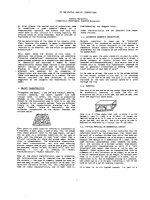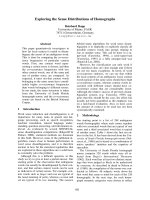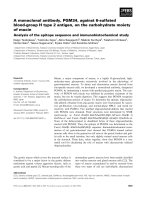The changing face of genomics doc
Bạn đang xem bản rút gọn của tài liệu. Xem và tải ngay bản đầy đủ của tài liệu tại đây (53.61 KB, 3 trang )
Genome Biology 2004, 5:324
comment
reviews
reports
deposited research
interactions
information
refereed research
Meeting report
The changing face of genomics
Manolis Kellis
Address: The Broad Institute, Massachusetts Institute of Technology and Harvard University, Cambridge, MA 02138, and Computer Science
and Artificial Intelligence Laboratory, Massachusetts Institute of Technology, Cambridge, MA 02139, USA. E-mail:
Published: 30 April 2004
Genome Biology 2004, 5:324
The electronic version of this article is the complete one and can be
found online at />© 2004 BioMed Central Ltd
A report on the 5th annual Advances in Genome Biology
and Technology (AGBT) and Automation in DNA Mapping
and Sequencing (AMS) meeting, Marco Island, USA, 4-7
February 2004.
The annual meeting on Advances in Genome Biology and
Technology was very different this year - in contrast to
previous years, only a handful of talks covered the latest
large-scale sequencing projects and the next species to be
sequenced. This meeting took for granted that we can
sequence, assemble and align complete genomes - achieve-
ments that only a few years ago seemed daunting, if not
unthinkable. The focus of the meeting has instead shifted
towards the new challenges in genomics, particularly in the
areas of gene regulation, cell dynamics and genome evolution.
Cell regulation and organism development
Given the primary sequence of a species, a major goal of
current genomics efforts is to understand the regulatory
mechanisms and control circuitry of the cell. Towards this
goal, Rick Young (Massachusetts Institute of Technology
and Whitehead Institute, Cambridge, USA) presented the
completion of the yeast protein-DNA interaction map. Using
chromatin immuno-precipitation (ChIP) technology in
combination with microarray ‘chips’ containing all intergenic
regions, his group has undertaken a genome-wide study of
the targets of all the roughly 200 transcriptional regulators
in yeast under multiple environmental conditions. They
characterized the sequence-specificity of these regulators
using numerous motif-discovery tools, together with
evolutionary sequence conservation and protein structure
information. The resulting regulatory map revealed general
principles of regulation in yeast, including the organizational
architectures of promoter regions (single motif, multiple
sites, multiple regulators or factor combinations), and the
different types of regulatory response to environmental
changes (off/on, invariant, expanded or altered). The Young
group also studied 20 chromatin regulators that do not
directly recognize DNA sequences, but instead rely on their
association with transcription-factor partners for binding
and can keep a record of transcription by maintaining
chromatin state. The Young lab is now moving this technology
into studying transcriptional-regulator binding in the
human genome, which will have applications to understanding
diseases from diabetes to cancer.
Michael Levine (University of California, Berkeley, USA)
presented work aiming to understand the cis-regulatory
circuitry of promoter regions in the fruitfly. He proposed
that enhancer complexity might be a better measure of
organismal complexity than overall gene count, and noted
that the majority of enhancer elements act cooperatively in
higher eukaryotes - autonomously-acting elements would in
fact be the exceptions. Levine’s group has studied the
promoter architecture of Drosophila developmental genes
that respond to different levels of the concentration gradient
of the developmental protein Dorsal. Five activation levels,
created by the combinatorial action of a three-response-level
activator and a repressor, were detected for this set of genes.
Levine and colleagues searched for conserved sequence
elements in the promoter regions of genes belonging to the
same activation level and discovered a common ‘grammar’ in
the organization of three basic enhancer elements. Searching
for a similar regulatory grammar in the mosquito genome
revealed ten genes with similar putative regulatory clusters,
two of which contain the same architecture, despite 230
million years of divergence.
Both Young and Levine have benefited from earlier work -
classical studies of gene function in yeast and known
developmental genes in the fly - that have set the foundations
for future studies. In this spirit, Nancy Hopkins
(Massachusetts Institute of Technology, Cambridge, USA)
presented her research program that aims to systematically
identify all developmental genes in the zebrafish. Zebrafish
is an appealing model for studying early vertebrate devel-
opment because of its transparent body and the short time
- a mere four days - between fertilization and free-swimming
larval stages. As reaching the adult stage takes another four
months, following multiple generations can, however, be
prohibitively slow. To face this challenge, Hopkins and
colleagues have used insertional mutagenesis to create
mosaic parents whose germ cells each contain a different
mutation. Following the fish with developmental defects and
classifying each mutation has allowed her group to screen
32,000 founder fish, identify 550 mutants and 390 loci, 298
of which have human homologs. As many as 20% of these
genes have no previously known biochemical function,
providing a great starting point for experimentation and new
biological discoveries. Additionally, the systematic approach
allows one to estimate the total number of developmental
genes, which Hopkins sets at 1,600, of which 25% have
already been isolated. The cost of identifying additional genes
increases as the study approaches saturation, however, and
her group is not planning to pursue the systematic discovery
phase of the work. They are currently working on under-
standing the genes identified and have revealed important
new insights about genes involved in kidney, jaw, liver and
myeloid cell formation.
Protein interactions and network evolution
Beyond the identification of genes involved in a developmental
process lies the major challenge of understanding the genes’
dynamic patterns of behavior during development. Josh
LaBaer (Harvard Medical School, Boston, USA) presented his
lab’s proteomics work enabling such a pursuit, which they
have approached by developing a ‘protein-expression clone
repository’ that contains full-length protein-coding sequences
for every gene in a number of model organisms, including
yeast, bacteria and human. These protein-coding sequences
are inserted into ‘master’ clone vectors and can be easily trans-
ferred to specialized vectors for expression studies, tagging
with green fluorescent protein (GFP) to study localization,
two-hybrid assays to determine protein interactions, or
expression in constructs to detect protein modification states
by mass spectroscopy. The system architecture is designed to
be flexible, modular, reliable, comprehensive and catalogued.
Mark Vidal (Harvard Medical School, Boston, USA) described
a similar system for understanding the worm proteome. His
lab is now mapping the localization of all 19,000 worm gene
products across development, and so building ‘chronograms’
of gene expression from the head to the tail. The patterns of
protein localization can then be clustered across space and
time, thus constructing the dynamic aspect of the protein-
interaction network of the worm. Vidal’s group has currently
completed 10% of the interactome matrix, and is moving
towards completeness with the goal of understanding not only
the components of the interactome but also protein behaviors
during complex organismal tasks.
The protein-interaction network of a species provides the
foundation for understanding the organism’s responses to
environmental changes and developmental signals. Across
evolutionary time, these responses change and the regulatory
circuits shift towards new ones. Lisa Stubbs (Lawrence
Livermore National Laboratory, Livermore, USA) presented
work aimed at understanding the evolution of such regulatory
mechanisms across species. Her group studied the KRAB-ZNF
family of chromatin-interacting zinc-finger transcriptional
regulators. These proteins arose 400 million years ago, after
divergence of land vertebrates from fish, and have recently
undergone lineage-specific expansions in the human and
mouse lineages via tandem duplications and deletions.
Researchers shy away from using traditional comparative
genomics tools for the analysis of such expanding gene
families, as orthologous pairs are hard to determine. In the
absence of orthology information, Stubbs constructed multiple
alignments of all paralogous gene copies within each species
in turn, rather than across species. This clever methodology,
although atypical, yielded biologically meaningful intergenic
sequence elements that are highly conserved across paralogs,
and which can be shown, on the basis of reporter assays, to
indeed act as enhancers. This approach also allowed the
identification of species-specific elements that have arisen
since the divergence of the mouse and human lineages.
Stubbs’ group is now working out the protein-level differences
between paralogs, with the goal of understanding how
structural changes affect function, in particular with respect
to tissue-specific regulation and parental imprinting.
Human divergence and diversity
Differences between more closely related species can be
much more subtle than the protein family expansions
observed between human and mouse. For example, divergence
between human and chimp shows as few as 12 changes every
1,000 nucleotides, which makes biological signal discovery a
real challenge. Mike Zody (Massachusetts Institute of
Technology and Broad Institute, Cambridge, USA) presented a
very interesting way to use such a close relative to reveal
insights into recent evolutionary history. Assuming that
neutral divergence between species and neutral diversity
within species are driven by the same underlying mutational
mechanisms, Zody and colleagues used human-chimp
divergence information to model the background mutation
rate for each region of the genome. Using this information,
they were able to distinguish regions of low within-human
diversity that were due to selective sweeps (where a favorable
mutation becomes incorporated into the genome very
quickly), rather than simply to a lower mutation rate. These
regions of low diversity were confirmed by genotyping
nucleotide polymorphisms in humans of different ethnicity
and building allele-frequency profiles. FOXP2, a well-known
gene involved in language development, showed only a
moderate signal for selection, whereas some regions that are
devoid of annotated genes showed very strong evidence of
324.2 Genome Biology 2004, Volume 5, Issue 5, Article 324 Kellis />Genome Biology 2004, 5:324
selection, raising new questions about what type of genetic
elements may be under selection in the human genome.
With the aim of understanding human variation and how
genetic differences may relate to phenotypic differences,
Joanna Mountain (Stanford University, USA) presented
her work relating language similarities to population
polymorphisms. In particular, she has studied the genetic
relationships of two geographically isolated populations in
Africa, both of which speak with clicking languages
(Khoisan). Using a multitude of metrics across various loci
and populations, she found that the genetic data clearly
support an evolutionarily distinct group for each of the two
languages. To explain the results, Mountain put forward
three possibilities: that the two languages arose indepen-
dently, that they traveled across populations, or that instead
the ancestral language was click-based and all intervening
groups lost the click sounds. One advantage to such click
languages might be the ability to communicate while
hunting without alerting the prey. The use of modern
genomics tools in the population genetics of language evolution
illustrates how diverse the genomics field has become, and
that, in fact, the maturity of genomics as a science has
moved its applications well beyond the boundaries of the
modern laboratory.
Overall, the meeting showcased a wide range of innovative
talks, combining ground-breaking technological inventions
with important scientific applications. The attendance was
unusually low this year, especially on the industry side,
witnessing the tight economic situation in the USA and
internationally. At the same time, the changing focus of the
meeting is evidence of a maturing field. Genomics has
mastered its initial challenges, and is now extending its arms
to embrace a growing number of fundamental questions in the
study of life.
comment
reviews
reports
deposited research
interactions
information
refereed research
Genome Biology 2004, Volume 5, Issue 5, Article 324 Kellis 324.3
Genome Biology 2004, 5:324









